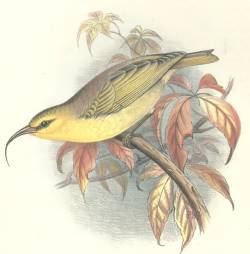Oʻahu nukupuʻu facts for kids
Quick facts for kids Oʻahu nukupuʻu |
|
|---|---|
 |
|
| Conservation status | |
| Scientific classification | |
| Genus: |
Hemignathus
|
| Species: |
lucidus
|
| Synonyms | |
|
Hemignathus lucidus lucidus |
|
The Oʻahu nukupuʻu (Hemignathus lucidus) was a special bird that used to live only on the island of Oʻahu in Hawaii. It was a type of Hawaiian honeycreeper, similar to other nukupuʻu birds found on Kauaʻi and Maui. Sadly, this bird is now extinct, meaning it no longer exists.
Contents
What the Oʻahu Nukupuʻu Looked Like
The Oʻahu nukupuʻu was a small, colorful bird. The male birds had bright yellow feathers on their belly and head. Their wing feathers were mostly olive green. They also had black markings around their eyes and black legs.
Female Oʻahu nukupuʻu birds and young birds looked similar to the males. However, their yellow feathers were not as bright. They were a duller yellow color.
A Special Beak
One of the most interesting things about the Oʻahu nukupuʻu was its unique beak. It had a long, curved beak that was about one and a half inches long. The top part of its beak was much longer than the bottom part. This special beak helped the bird find its food.
What the Oʻahu Nukupuʻu Ate
The Oʻahu nukupuʻu used its long, curved upper beak like a tool. It would use it to pull insects out from under the bark of trees. These birds mainly ate insects found on flowering trees.
They often looked for food on koa trees (Acacia koa) and oʻhia trees (Metrosideros polymorpha). These trees have flowers full of sweet nectar, which attracts many insects. The Oʻahu nukupuʻu would eat insects from koa trees in high mountain forests. In lower areas, they would feed on insects from oʻhia trees.
Why the Oʻahu Nukupuʻu Disappeared
The Oʻahu nukupuʻu is believed to have vanished because of several problems. One major issue was the spread of diseases. These diseases killed off many nukupuʻu birds across the Hawaiian islands.
Another problem was the introduction of new animals to Hawaii. For example, mongooses were brought to Hawaii to help control rats in sugar cane fields. However, mongooses are also predators. They were suspected of stealing nukupuʻu chicks from their nests. This made the bird's population drop even faster.
The Last Sightings
Naturalists and bird experts tried to study and find the Oʻahu nukupuʻu. In 1837, a naturalist named Ferdinand Deppe and a bird expert named John Kirk Townsend collected about nine specimens of the bird. A few more birds were collected until 1841.
After that, it became very hard to find the Oʻahu nukupuʻu. A bird expert named Robert Cyril Layton Perkins searched widely for the bird. However, by the early 2000s, the Oʻahu nukupuʻu was officially considered extinct.


